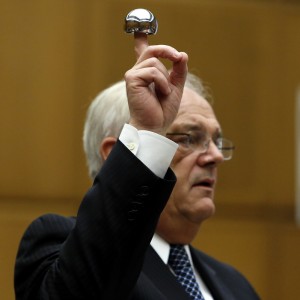The world’s largest seller of health-care products has revealed the Justice Department is investigating possible false claims related to the hip devices.
In the meantime, 10,000 lawsuits have been consolidated into pending class action suits in Toledo, San Francisco and Los Angeles.
Loren Kransky’s case is the first to go to trial. He’s a retired prison guard who got an ASR XL hip implant in 2007. In 2012, after his doctor noticed it was shedding metal ions into his blood stream, Kransky had the device removed and replaced.
“The ASR XL was dangerous and it was defective in design and we will prove it,” Kransky’s lawyer, Michael Kelly, said in his opening statement last month.
“It was seen as a revolutionary device,” says Voreacos. “Patients were told it would last 20 years.” Since most models last about 15 years, the device was particularly attractive to young patients hoping to regain mobility lost from conditions like arthritis or lupus.
Then there's the issue of toxicity. It turns out the ASR also has a tendency to leach cobalt and chromium ions into the bloodstream.
“It’s sort of a long term question, the health effect of those ions.” Voreacos says.
Reporter Barry Meier of the New York Times is more blunt. In a recent article, he wrote, “Tiny particles of metallic debris released as the artificial joints move have caused severe tissue and bone damage in hundreds of patients, leaving some of them disabled.”
Even if a person isn’t left disabled, a hip implant surgery requires removing bone. So if the device fails to take, or the ion issue prompts a person to want to get rid of the ASR, replacing the hip can be a painful business. The more surgeries, the more bone material is removed from the joint. Most artificial hip recipients speak glowingly of the mobility they've regained, but it's fair to say the fewer the number of surgeries in a lifetime, the better.
Prosecutors in Los Angeles Superior Court point to another data set coming from Australia that suggested the ASR would fail in 44 percent of patients within seven years - eight times the failure rate of most orthopedic implants.
You might be thinking this is just the kind of situation pre-market clinical studies are designed to forestall. You’d be right, but federal rules do not require it for all medical devices. Only now is the Food and Drug Administration proposing that makers of artificial hips with all-metal components prove the devices are safe and effective before they continue selling existing ones or get approval for new all-metal designs.
Currently, companies have to show only that their devices resemble ones already on the market. Over the years, the FDA repeatedly started the process required to classify all-metal hips as high-risk products rather than moderate-risk ones, but federal officials never crossed the goal line -- in part due to heavy lobbying from industry.
The FDA is reportedly moving now to close that loophole in the Medical Device Amendments of 1976.
In the meantime, the use of all-metal implants has plummeted, with the devices now accounting for about five percent of hip implants. But as Voreacos notes, evidence presented in the Kransky trial suggests all all-metal hips are not alike. The ASR failure rate is the highest of any hip implant, in any class.
So that’s one compelling back story to the story of the ASR hip. The other one is the apparent complicity of consulting hip specialists. Surgeons developed the design, including one at UCSF and another in Los Angeles who is the Joint Replacement Section Editor for Orthopedics Today. One presumes medical devices are best developed by the top names in any given field, and naturally, they should receive royalties on those devices. But that creates a structural incentive to downplay reports of problematic outcomes from other surgeons in the field.
DePuy denies all the claims pending in Los Angeles -- and it also argues Kransky's claims are particularly suspect. Hip or no hip, he's struggled with a laundry list of health problems, including diabetes, coronary artery disease, high blood pressure, kidney disease, strokes and cancer. That may affect the strength of this case as a precedent setter.
A couple more cases are headed to trial, including one in Chicago and one in Toledo. Lawyers are both sides are expected to use what happens in these first three trials to set parameters for settlements.
In any case, a new development just out today does not bode well for Johnson & Johnson.
The FDA has notified healthcare professionals of a Class I recall, the most serious type, of another orthopedic device made by Johnson & Johnson: the LPS Diaphyseal Sleeve, used in reconstructive knee surgery. It was recalled because of the potential for fractures, the FDA said.
"The FDA has received a total of 10 reports (6 fractures and 4 reports of loosening that may or may not be attributed to the same device design issue) of incidents in which the device has malfunctioned."
And further, this:
